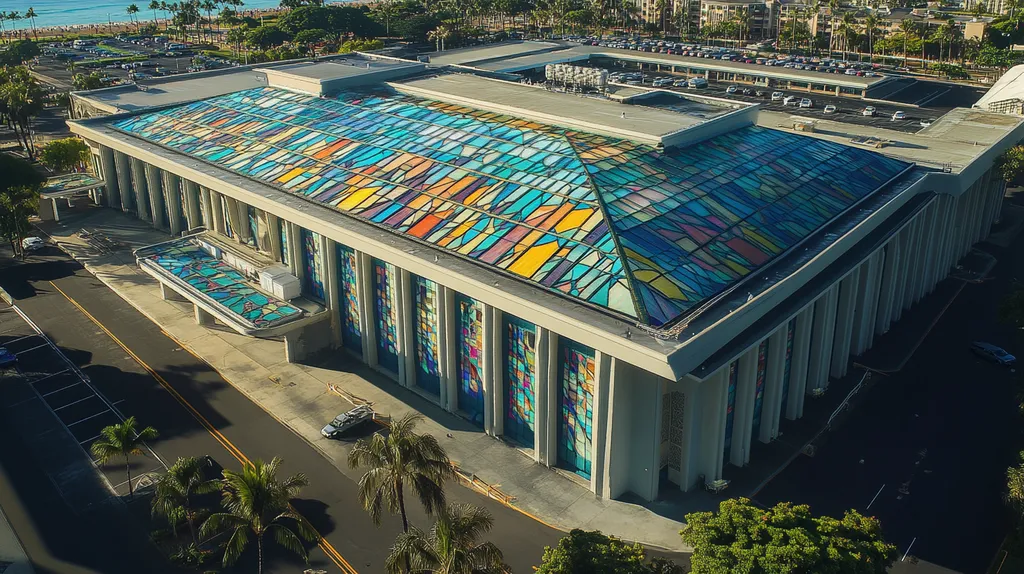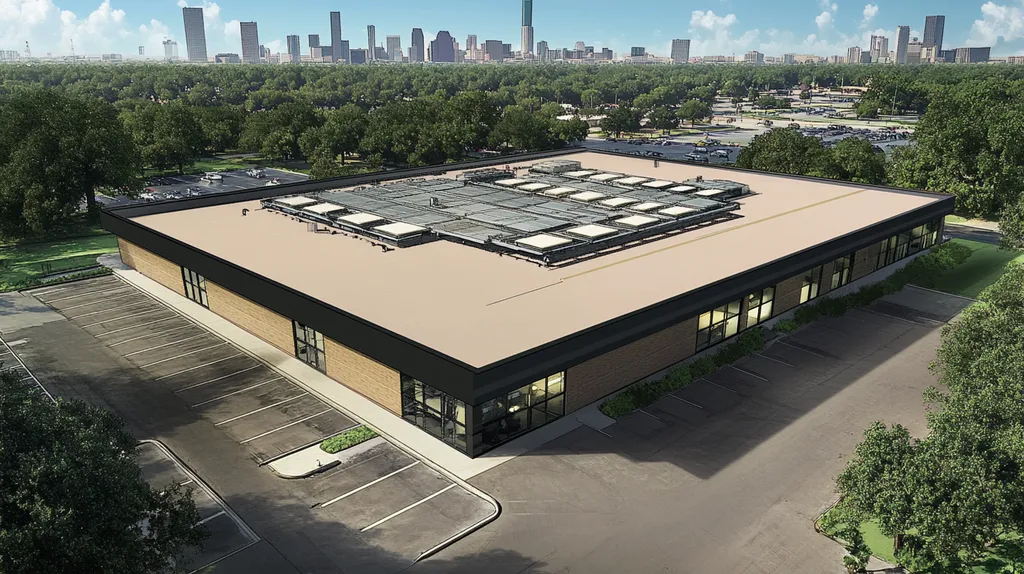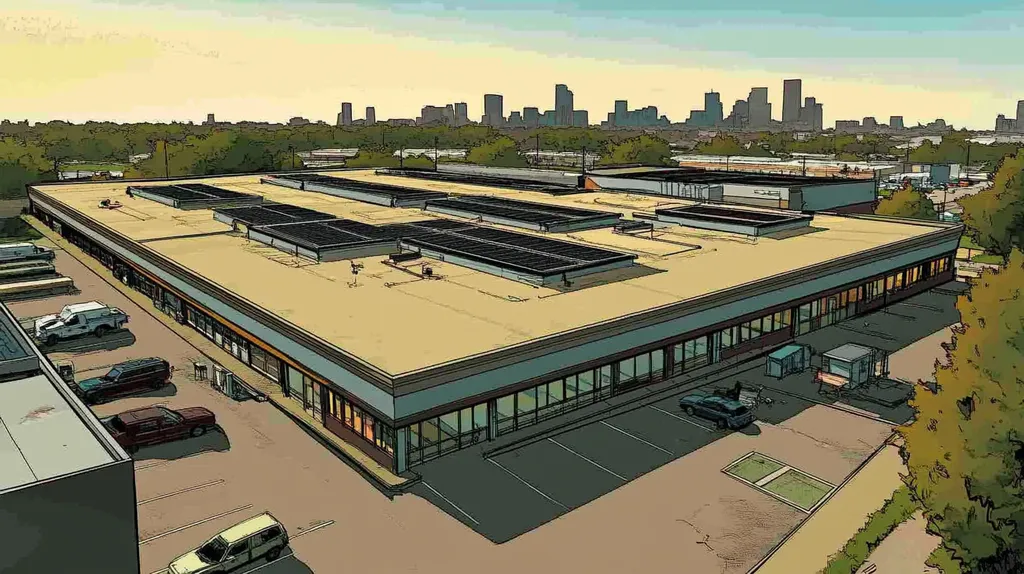Welcome to today’s Battle Royale featuring two roofing heavyweights: “TPO” in the east corner versus “PVC” in the west!
Tonight’s showdown pits these contenders against each other across six punishing rounds designed to test every aspect of their performance for Commercial Roof Handling Extreme Weather Conditions.
At stake? Millions in potential costs, decades of building protection, and the critical performance demands of modern commercial and industrial facilities.
Our professional judging panel will evaluate each round on technical merit, real-world performance, and value delivery. After all six rounds, we’ll declare our ultimate champion.
Ladies and gentlemen, facility managers and building owners… it’s time to rumble!
ROUND 1: INITIAL COSTS & INSTALLATION
In an era of increasingly extreme weather events, selecting the right commercial roofing material has become more critical than ever. The choice between TPO and PVC roofing systems can impact not just immediate costs, but long-term building resilience and financial planning.
Property owners and facility managers must weigh multiple factors when making this crucial decision. Understanding the nuances of material costs, installation requirements, and project timeframes can mean the difference between a successful investment and a costly mistake.
Material Expenses
TPO membranes offer exceptional durability at a competitive price point, typically ranging from $3.50 to $5.00 per square foot. These membranes blend polypropylene and ethylene-propylene rubber, creating a material specifically engineered to withstand damage from hail, heavy winds, and temperature fluctuations. (source: Allweather Roof)
PVC roofing materials command a premium price, usually between $6.00 to $8.50 per square foot. This higher cost reflects PVC’s advanced chemical resistance and enhanced welded seam strength.
While both materials offer strong performance characteristics, TPO’s lower initial cost earns it the “ADVANTAGE” in this category.
Installation Complexity
TPO installation benefits from the material’s lightweight nature and flexible composition. The simplified installation process requires fewer specialized tools and typically involves fewer layers than alternative systems.
PVC installation demands more technical expertise and specialized equipment. The process includes careful seam welding and detailed attention to flashing details, which can increase both labor costs and the potential for installation errors.
Given its more straightforward installation requirements and lower labor demands, TPO claims the “ADVANTAGE” in installation complexity.
Project Timeline
TPO installations typically complete within 5-7 working days for an average commercial property. This efficiency stems from simpler installation procedures and fewer required layers.
PVC projects often require 7-10 working days or more to complete. The extended timeline results from more complex installation procedures and additional quality control measures for seam welding.
With its faster completion time and reduced business disruption, TPO earns the clear “ADVANTAGE” in project timeline considerations.
ROUND 1 WINNER: TPO
ROUND 2: DURABILITY & LIFESPAN
As extreme weather events become more frequent and intense, the durability of commercial roofing systems faces unprecedented challenges. Property owners must now consider how their roofing choices will perform not just under normal conditions, but during severe storms, extreme temperature swings, and prolonged UV exposure.
The stakes are particularly high for facilities in regions experiencing climate-driven weather patterns. A roof’s ability to maintain its integrity through these conditions directly impacts building protection, operational continuity, and long-term maintenance costs.
Material Strength
TPO membranes demonstrate exceptional tensile strength and puncture resistance, crucial factors in regions prone to hail and debris impact. Their reinforced composition allows these membranes to maintain structural integrity even under significant stress.
PVC roofing systems offer comparable impact resistance but excel particularly in chemical resistance. Their molecular structure provides superior protection against industrial pollutants and harsh chemicals that can degrade other roofing materials.
When comparing overall material resilience in extreme conditions, TPO demonstrates slightly better performance metrics, earning the ADVANTAGE in this category.
Weather Resistance
Single-ply membranes like TPO and PVC demonstrate remarkable effectiveness in climates with intense UV exposure, helping maintain energy efficiency and reduce cooling costs. Their reflective properties and heat-resistant formulations make them particularly suitable for harsh environmental conditions. (source: Solariasolarandroofing)
TPO maintains exceptional flexibility in extreme temperatures, resisting cracking and thermal shock. Its white surface reflects UV rays effectively, reducing heat absorption and thermal stress.
PVC exhibits similar UV resistance and thermal properties, with the added benefit of superior resistance to chemical exposure. Both materials perform admirably in extreme weather conditions, resulting in a TIE for this category.
Maintenance Requirements
TPO roofing systems typically require minimal routine maintenance beyond regular inspections and basic cleaning. Their durable surface resists accumulation of dirt and biological growth, reducing the need for intensive cleaning protocols.
PVC systems demand more specialized maintenance attention, particularly around seams and flashings. Their chemical resistance comes at the cost of more complex repair procedures when damage does occur.
Given the lower maintenance burden and simpler repair requirements, TPO claims the ADVANTAGE in this category.
ROUND 2 WINNER: TPO
ROUND 3: PERFORMANCE FACTORS
The increasing frequency and intensity of extreme weather events pose unprecedented challenges for commercial roofing systems. From destructive hailstorms to punishing UV exposure, modern roofs must withstand conditions that can rapidly deteriorate inferior materials and compromise building integrity.
Property owners and facility managers must carefully evaluate how different roofing materials perform under severe stress. Understanding these performance factors is crucial for protecting assets and maintaining operational continuity during extreme weather events.
Wind Resistance
Wind resistance has become a critical performance factor as severe storms become more frequent. High winds can create powerful uplift forces that stress roofing systems beyond their design limits, potentially leading to catastrophic failures.
TPO membranes demonstrate excellent wind resistance due to their flexible nature and strong seam welds. Their lightweight composition allows them to flex and adapt to wind pressures without compromising structural integrity.
PVC systems offer superior wind resistance through their rigid composition and reinforced membrane structure. Their enhanced chemical bonding at seams provides exceptional resistance to wind uplift forces, even in hurricane-prone regions.
Given its superior performance in extreme wind conditions, PVC earns the ADVANTAGE in this category.
Thermal Performance
TPO membranes demonstrate exceptional puncture resistance and durability while maintaining superior heat-reflective properties. Their ability to resist tears and impacts makes them particularly effective in managing thermal stress during extreme temperature fluctuations. (source: allweatherroof.com)
PVC roofing systems also provide strong thermal performance through their reflective surface and insulation properties. However, they can become more brittle over time when exposed to extreme temperature cycles.
With its superior long-term thermal stability and resistance to temperature-related degradation, TPO claims the ADVANTAGE in thermal performance.
Moisture Resistance
Water infiltration represents one of the most significant threats to commercial roofing systems. Even minor leaks can lead to extensive damage to building interiors and compromise structural integrity.
TPO roofing systems feature heat-welded seams that create permanent, watertight bonds. Their membrane composition resists water absorption and maintains integrity even during prolonged exposure to standing water.
PVC systems provide excellent moisture resistance through their chemical composition and welded seams. However, they can be more susceptible to seam failures if installation quality is compromised.
Based on superior long-term moisture resistance and seam reliability, TPO takes the ADVANTAGE in this category.
ROUND 3 WINNER: TPO
ROUND 4: MAINTENANCE REQUIREMENTS
In today’s volatile climate conditions, proper roof maintenance has become more critical than ever for commercial properties. Studies show that inadequate maintenance can slash a roof’s functional lifespan by up to 60%, leading to premature replacement costs that can exceed $100,000 for average commercial buildings.
As extreme weather events increase in both frequency and intensity, the difference between a well-maintained and neglected roof system can mean the difference between business continuity and catastrophic failure.
Routine Inspections and Repairs
Comprehensive inspection protocols represent the foundation of effective commercial roof maintenance. Early detection of potential issues prevents minor problems from escalating into major structural concerns.
TPO systems typically require bi-annual professional inspections, with their durable composition and heat-welded seams showing remarkable resistance to environmental stressors. Their uniform surface makes damage identification straightforward, allowing for timely intervention.
PVC roofing demands quarterly inspections due to its more complex seam structure and potential chemical interaction vulnerabilities. While highly durable, PVC systems require more specialized expertise during maintenance evaluations.
Given its reduced inspection frequency requirements and simpler evaluation protocols, TPO claims the ADVANTAGE in this category.
Cleaning and Surface Maintenance
Regular cleaning and surface maintenance directly impact a roof’s performance and longevity. Accumulated debris, standing water, and biological growth can accelerate material degradation and compromise structural integrity.
TPO membranes feature a smooth, non-porous surface that naturally resists dirt accumulation and biological growth. Their chemical composition allows for simple cleaning procedures using standard commercial cleaning solutions.
PVC systems, while resistant to chemical exposure, can develop more stubborn surface contamination over time. Their textured surface often requires more intensive cleaning protocols and specialized cleaning agents.
With its simplified cleaning requirements and superior dirt resistance, TPO earns the ADVANTAGE in this category.
Long-term Durability Requirements
The ability to maintain structural integrity under extreme conditions directly impacts long-term maintenance demands. Systems that better resist environmental stressors require fewer interventions and repairs over their lifespan.
TPO membranes demonstrate exceptional resistance to UV degradation and thermal stress, maintaining their protective properties with minimal intervention. Their flexible composition adapts to building movement while resisting punctures and tears.
PVC systems offer comparable durability but may require more frequent seam maintenance and chemical resistance testing. Their rigid structure, while robust, can become more maintenance-intensive as the system ages.
Based on lower long-term maintenance requirements and superior aging characteristics, TPO secures the ADVANTAGE in this category.
ROUND 4 WINNER: TPO
ROUND 5: SUSTAINABILITY CREDENTIALS
As global environmental standards tighten and energy costs soar, sustainable roofing choices have become a critical business imperative. Commercial properties now face increasing pressure to reduce their carbon footprint while maintaining operational efficiency, with roofing systems playing a pivotal role in achieving these goals.
Modern facility managers must balance immediate performance needs with long-term environmental impact. The right roofing choice can reduce energy consumption by up to 30% while minimizing landfill waste and supporting corporate sustainability initiatives.
Environmental Impact
The manufacturing process and chemical composition of roofing materials directly affect their environmental footprint. Understanding these impacts has become crucial as regulations around building materials tighten and stakeholders demand greater environmental responsibility.
TPO membranes utilize environmentally conscious manufacturing processes that produce minimal harmful byproducts. Their production requires less energy than traditional materials, and the finished product contains no chlorines or plasticizers that could harm the environment.
PVC roofing manufacturing generates concerning levels of chlorine-based byproducts and requires significant energy input. While modern PVC formulations have improved, they still carry a heavier environmental burden than TPO alternatives.
Based on cleaner manufacturing processes and reduced environmental impact, TPO claims the ADVANTAGE in this category.
Material Recyclability
End-of-life management has become a critical factor in roofing material selection. The ability to recycle and repurpose materials can significantly reduce landfill impact and support circular economy initiatives.
TPO membranes can be fully recycled at the end of their service life, with many manufacturers offering take-back programs. The material can be processed into new roofing products or repurposed for other applications, creating a closed-loop system.
PVC roofing presents significant recycling challenges due to its chemical composition. While technically recyclable, the process is more complex and expensive, leading many PVC roofs to end up in landfills.
Given its superior recyclability and established recycling programs, TPO earns the ADVANTAGE in this category.
Energy Performance
Building energy efficiency has become paramount as organizations seek to reduce operational costs and meet sustainability targets. Roofing choices significantly impact heating and cooling demands throughout the building’s lifecycle.
TPO membranes feature highly reflective surfaces that maintain their solar reflectance properties over time. This characteristic reduces cooling loads and helps mitigate urban heat island effects, particularly in warmer climates.
PVC roofing systems offer good initial reflectivity but may lose some effectiveness as they age. Their energy performance, while acceptable, typically doesn’t match TPO’s long-term reflective properties.
With superior long-term energy performance and consistent reflectivity, TPO secures the ADVANTAGE in this category.
ROUND 5 WINNER: TPO
ROUND 6: SPECIALIZED APPLICATIONS
As extreme weather events intensify, specialized roofing applications have become critical for protecting commercial properties. Recent data shows that inadequate roofing choices in challenging environments can lead to catastrophic failures, with repair costs often exceeding $500,000 for large commercial facilities.
Understanding how different roofing materials perform under specific environmental stresses has never been more crucial. The choice between TPO and PVC can significantly impact a building’s resilience against severe weather conditions.
Chemical Exposure Resistance
Industrial facilities, laboratories, and manufacturing plants often expose roofing systems to harsh chemicals, acids, and pollutants. These environmental factors can rapidly degrade standard roofing materials, leading to premature failure.
TPO membranes offer good baseline chemical resistance but can show vulnerability to prolonged exposure to certain industrial chemicals. Their performance may deteriorate when repeatedly exposed to strong acids or petroleum-based products.
PVC roofing systems demonstrate superior resistance to chemical exposure, maintaining their structural integrity even under harsh industrial conditions. Their molecular structure provides exceptional protection against a broad spectrum of chemical agents.
With its superior chemical resistance and proven track record in industrial applications, PVC claims the ADVANTAGE in this category.
High-Temperature Applications
Modern commercial facilities often house equipment that generates significant heat, creating unique challenges for roofing systems. Restaurant exhaust systems, industrial vents, and HVAC equipment can create localized hot spots that stress roofing materials.
TPO membranes maintain flexibility and structural integrity under high temperatures, with newer formulations specifically engineered to resist heat aging. Their reflective properties help dissipate heat effectively around rooftop equipment.
PVC systems show excellent heat resistance but can become brittle over time when exposed to extreme temperature fluctuations. Their performance around high-temperature exhaust systems may require additional protective measures.
Given its superior long-term heat resistance and flexibility, TPO earns the ADVANTAGE in this category.
Safety and Code Compliance
Single-ply membranes like TPO and PVC demonstrate remarkable effectiveness in climates with intense UV exposure, helping maintain energy efficiency and reduce cooling costs. Their reflective properties and heat-resistant formulations make them particularly suitable for harsh environmental conditions. (source: Solaria Solar & Roofing)
TPO systems meet basic safety requirements but may require additional modifications to achieve higher fire ratings. Their standard formulation provides good baseline protection for most commercial applications.
PVC roofing inherently offers superior fire resistance and meets the most stringent safety codes without modification. Its chemical composition naturally inhibits flame spread, making it ideal for facilities with strict safety requirements.
Based on superior inherent safety characteristics and code compliance, PVC claims the ADVANTAGE in this category.
ROUND 6 WINNER: PVC
AND THE WINNER IS…
After six grueling rounds of technical combat, we have our verdict! With a dominant performance winning five out of six rounds, TPO emerges as our heavyweight champion of commercial roofing for extreme weather conditions!
TPO’s victory comes from its outstanding performance across multiple critical categories. This champion demonstrated superior cost-effectiveness, exceptional durability, remarkable maintenance efficiency, and impressive sustainability credentials. Its ability to deliver high performance while maintaining a competitive price point proved decisive in this matchup.
But don’t count PVC out of the fight! This worthy challenger showed its specialized strengths in Round 6, dominating chemical resistance categories and proving itself the superior choice for industrial facilities facing harsh chemical exposure and stringent safety requirements.
Remember, ladies and gentlemen, while we’ve witnessed a decisive victory today, every building tells its own story. Local climate conditions, specific facility requirements, and unique property characteristics can all impact roofing performance. Professional consultation remains essential for matching your specific situation with the right roofing solution.
In the high-stakes arena of commercial roofing, there’s no substitute for informed decision-making. Whether you choose our new champion TPO or the specialized strengths of PVC, victory comes from matching your facility’s unique challenges with the right contender’s capabilities!
FREQUENTLY ASKED QUESTIONS
Q. What are the initial costs for a commercial roof installation?
A. Initial costs vary, with TPO roofs ranging from $3.50 to $5.00 per square foot, while PVC typically costs between $6.00 and $8.50 per square foot. Choosing the right material can impact long-term financial planning significantly.
Q. How do TPO and PVC compare in durability for industrial roofs?
A. TPO offers excellent tensile strength and puncture resistance, making it durable under extreme conditions. PVC also performs well, especially against chemical exposures, but TPO generally shows better performance metrics overall when considering durability.
Q. Which roofing material performs better in extreme weather conditions?
A. When it comes to performance during storms, PVC offers superior wind resistance due to its rigid composition. However, TPO excels in moisture resistance and flexibility, making it more adaptable in extreme weather scenarios.
Q. What are the maintenance requirements for commercial roofs?
A. TPO typically requires bi-annual inspections and minimal routine maintenance, while PVC needs quarterly evaluations due to its complex seams. The type of roof impacts not only the maintenance frequency but also repair procedures.
Q. How do TPO and PVC impact sustainability in roofing?
A. TPO roofs are manufactured with minimal environmentally harmful byproducts and are fully recyclable. PVC, while durable, carries a heavier environmental impact due to its production processes and is more challenging to recycle, affecting sustainability efforts.
Q. Which roofing material is better for specialized applications?
A. PVC offers superior chemical resistance and is better suited for environments with harsh industrial chemicals. TPO maintains good performance under high temperatures but is less resilient in harsh chemical applications, making the choice dependent on specific needs.
Q. What’s the average lifespan of a commercial roof?
A. The lifespan of a commercial roof depends on the material; TPO generally lasts 20-30 years, while PVC can last up to 30 years with proper maintenance. Factors like climate and installation quality also impact longevity significantly.











